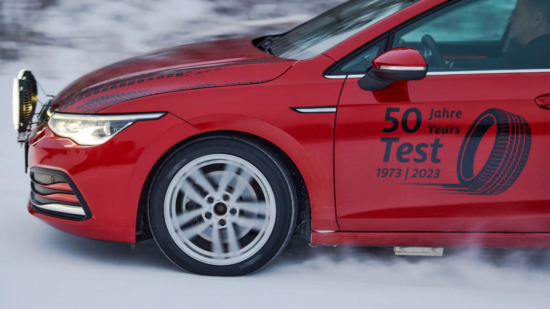Four ‘good’ tyres in motoring clubs’ size 225/45 R17 test
 This year is ADAC’s tyre testing golden anniversary (Photo: ADAC/Marc Wittkowski)
This year is ADAC’s tyre testing golden anniversary (Photo: ADAC/Marc Wittkowski)
The days are getting shorter and cooler, but we don’t need to go outdoors to realise that winter is fast approaching – the glut of seasonal tyre tests give the game away. European motoring associations ADAC, TCS and ÖAMTC are readying their members by testing winter tyres in two dimensions. Here we look at 225/45 R17, a popular size for cars such as the Audi A3, Mercedes A-Class and – the test team’s chosen vehicle – the VW Golf.
The Austrian, German and Swiss clubs evaluated 16 brands of tyre. The results here are those reported by the ADAC, which this year celebrates 50 years of tyre testing. None of the 16 tyres achieved ADAC’s highest ‘very good’ rating but the association scored four candidates as ‘good’. ADAC rated a further 11 tyres as ‘satisfactory’ but gave one the unpropitious ‘deficient’ rating.
Four good tyres
Test winner the Continental TS 870 manages to combine excellent driving performance and the best possible environmental balance with top-notch qualities on wintry and wet roads. Even though the Bridgestone Blizzak LM005 performed even better than the Continental tyre in the wet, its behaviour on snow and ice was relatively weak (in the tested dimension) and resulted in a lower overall rating.
The Michelin Alpin 6 and Goodyear Ultra Grip Performance + also score a ‘good’ rating with very similar performances, although the Michelin tyre is a nose ahead in the environmental balance category due to its better predicted mileage (61,000 kilometres, Goodyear 54,400 kilometres). With a similarly high mileage potential and correspondingly good environmental balance, the Dunlop Winter Sport 5 also secures a spot on the podium despite slight weaknesses in the wet.
Rated satisfactory
When looking at the 11 tyres that ADAC rated as ‘satisfactory’ it is particularly important to bring individual driving preferences into the equation. This is because the group includes tyres that have slight weaknesses either on dry, wet or wintry roads, but score well for environmental performance. Motorists whose driving requirements enable them to live with a specific weakness may even find a bargain.
The Pirelli Cinturato Winter 2, Nokian Tyres WR Snowproof and Sava Eskimo HP2 show clear weaknesses on dry roads. Although the Pirelli tyre makes up for this on wet and wintry roads, neither the Nokian nor the Sava convince in the wet.
On wet roads, the aforementioned Bridgestone Blizzak LM005 gains top marks ahead of the Hankook Winter i*cept RS3 but squandered a better overall result due to weaknesses on wintry roads. Snow and ice also proved a challenge for the Yokohama BlueEarth-Winter V906, Apollo Aspire XP Winter and Semperit Speed Grip 5.
The Bridgestone tyre gained the wooden spoon for environmental balance a predicted mileage potential of 36,100 kilometres and high tyre wear. Here, the Kumho Wintercraft sets the standard in this size with 64,000 kilometres – even ahead of the wear-resistant Michelin Alpin 6 (61,000 kilometres).
A deficient tyre
At the bottom of the table is the Kormoran Snow. In addition to delivering the worst performance on dry roads, it additionally did so in the wet. ADAC presents wet braking as an example of this: At the point where the test vehicle fitted with Hankook Winter i*cept tyres is already stationary, the Kormoran-shod car is still travelling at 36 km/h.
With the worst results in straight and sideways aquaplaning as well as low levels of grip, early understeer and oversteer in the curves of the wet handling course, ADAC says it can only describe the Kormoran Snow as ‘deficient’. Not even its snow performance – which was “by far the best” of the 11 tested tyres – suffices to redeem it.






Comments